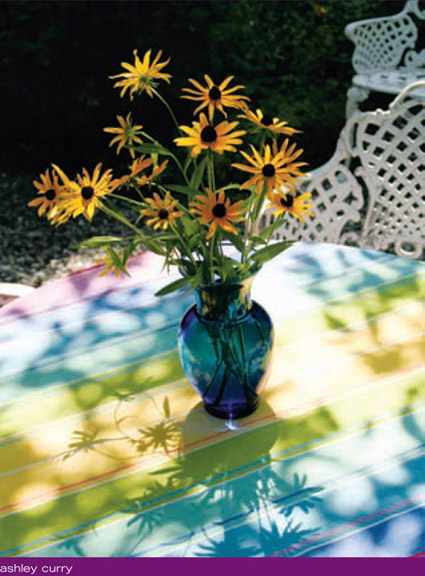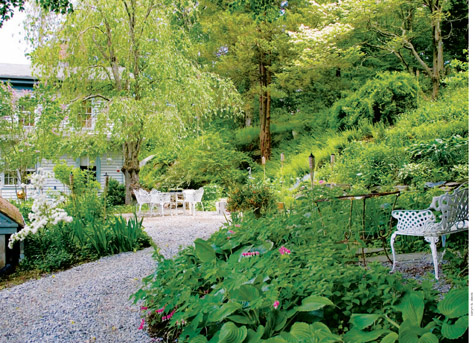
LEFT: From the stone and pebble patio beside Leif’s house, the gardens climb the hillside to a tree-lined ridge.

LEFT: From the stone and pebble patio beside Leif’s house, the gardens climb the hillside to a tree-lined ridge.
Leif Nilsson strides through his gardens, pointing out works in progress: a stone wall he plans to alter, a failing tree that may be removed, a bed of perennials that is slated for transplant to a different location. He stops to point out how the morning light is grazing the eastern corner of his house and changing the colors in the shadows of the gray clapboards. In his studio he chronicles the shifting back and forth between brush and palette knife and how it has helped him develop his technique. While studying one painting of the garden, he speculates that the gravel path it depicts might look better built of large, flat stones.
For Leif the push-pull between gardening and painting is constant, with neither one remaining static for long. Because he paints exclusively from life in the plein air style, this connection is not only visual, it’s physical. He’ll keep working on a scene of his flowering cherry tree until the blossoms have dropped to the ground. Or he may decide to plant a flat of annuals to provide a particular color he wants to paint in the corner of a canvas.
Leif’s gardens start as a series of raised beds and potted annuals in front of his studio, located in the town center of tiny Chester, Connecticut. The beds wrap around to a set of stone stairs that lead up along the historic building that houses his gallery and residence and continue to pea-stone paths and brick patios surrounded by mature trees, flowering shrubs, stone walls, and beds of perennials. From there the gardens fan out and continue to climb up a steep hillside crisscrossed with stone steps until they culminate at a common green space at the top of a ridge he shares with his neighbors.

ABOVE: English ivy covers a multipane window in Leif’s studio.
The history of the gardens chronicles Leif’s relationship with this location, beginning in 1990 when he rented the carriage house as a gallery for his impressionistic paintings. Unsuited to a sedentary life, he planted annual window boxes as subjects to paint during gallery hours. To discourage vehicles from blocking the door, he built wooden planters and filled them with snap-dragons, painting them from every angle for the next several years. In 1995 he bought the half-acre property, and the real work of creating the landscape began.
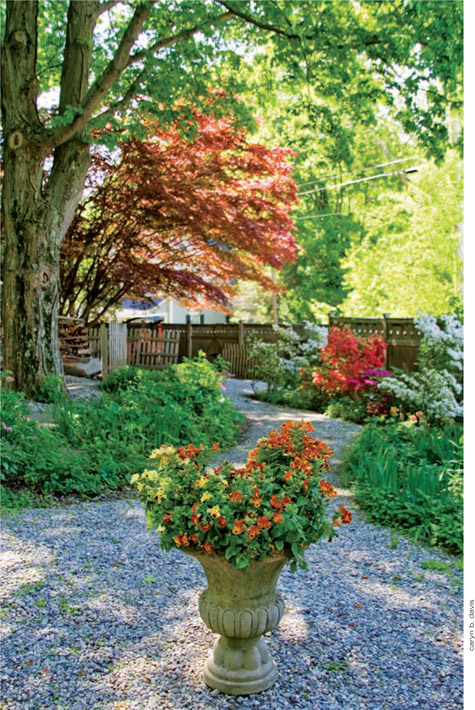
An urn of yellow and orange monkey flowers in the dappled shade of a stone path might become an element in one of Leif’s many paintings of his gardens. caryn b. davis
An infestation of termites in the house led to a major renovation and the rental of a tractor. Before building a new foundation, Leif had to break up the existing concrete patio and move huge piles of earth and stone from the old basement to elsewhere on the property. New wooden doors and windows, granite steps, a much-needed drainage system, and a handsome new brick courtyard, complete with outdoor lighting and a sound system, emerged from the dust. By the time the construction was finished, Leif owned his own earth-moving equipment and had set his sights on the backyard.
With nothing but a large lawn, some ground cover plants, and a few shrubs, the backyard looked much like a blank canvas to the artist. Inspired by a recent trip to the palace and fortress complex of Alhambra, in Grenada, Spain, Leif started by terracing the hillside. When British settlers first cleared the Connecticut forest for farming, one could hardly put a shovel into the ground without hitting a rock. Today, beautiful old stone walls meander though town and country all across the state and give the land its graceful rusticity. The ground still yields plenty of cobbles; with the rocks he unearthed, Leif built walls and steps and walkways that helped define the gardens and provide access to the upper portions of the property. He used what he had learned from his grandfather, a professional gardener, and from his early jobs in landscaping to prepare the land, doing backhoe work with a local horse farmer in exchange for manure to enrich the soil. (He would later barter this same service for much-needed massage therapy.)
Ferns and hostas provided a base for the hillside garden. Leif added plants donated by family and friends: phlox, perennial sunflowers, bee balm, and daylilies. Forsythia, rose of Sharon, and spirea grew to create a privacy screen on one edge of the yard. Along the street-side fence he planted shoots from his grandmother’s rhododendrons and lilacs among the native asters and azaleas. He bought roses, peonies, and hydrangeas for the flower beds that wind around the pea-stone patio, planted his grandmother’s English ivy to cover the walls of the studio and the ground under the cherry tree, and seeded annual sunflowers to greet visitors at the gate. He continued to carve out the hardscape, widening paths, redirecting walls, altering walkway surfaces. Over the years he has filled the yard to overflowing with dozens of species of trees, flowering shrubs, perennials, spring bulbs, vines, and ground covers as well as pots and planters of colorful summer annuals. As evidenced by many of his paintings, the gardens have long been a spectacular show of color and texture, shadow and sunlight.

ABOVE: A mix of ferns and hostas grows in the shadows of rock walls throughout the yard.
Leif’s enthusiasm for his garden seems to be at least partially rooted in his ability to transform it almost at will. (Each spring while most of the vegetation is still small, he gets the uncontrollable urge to move things.) In fact, hard work, determination, and a high level of skill with landscaping equipment are what have made these ever-evolving gardens possible. Rock walls have been dismantled and rebuilt to create new sitting areas, and mounds of soil have been moved and the resulting level areas filled with shrubs and perennials dug from other parts of the yard. The physical activity suits Leif’s high-energy personality and keeps him in shape. The other compelling force for this continual change is that it provides him new subject matter for the next series of garden paintings.
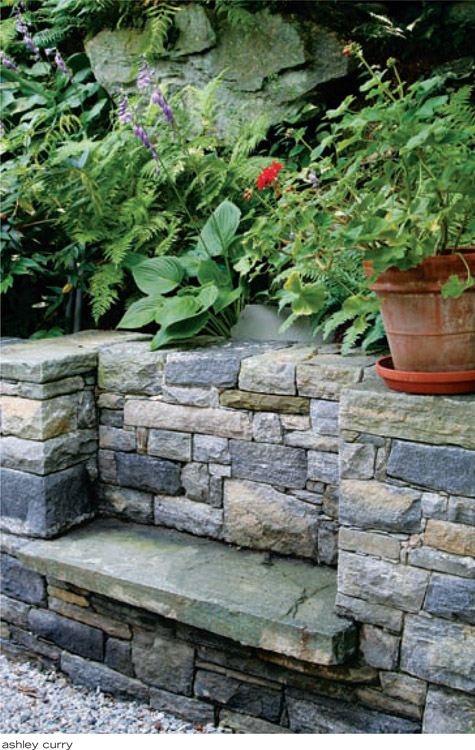
ABOVE: A bench built into a wall of native stone offers one of many opportunities to sit and consider the gardens.
Since childhood Leif had been drawn to the solitary act of making art. He worked in pencil, watercolor, and acrylic through high school, then at eighteen he packed his supplies and embarked on a cross-country trip. He hitchhiked as far as South Dakota, where he stumbled upon the Black Hills International Survival Gathering and was inspired by Lakota activist and artist Russell Means to explore his own ancestry. He got to know his grandfather, then traveled to Europe for seven months, spending time in Sweden, where he lived and worked with his extended family. Once back home, he resumed working for gardening clients and, with a full scholarship awaiting him, was able to finish his art school education. He first focused on life drawing to build a solid base, but always knew that studio work was not for him. So after graduation he scheduled his workdays around plein air landscape painting.

ABOVE: Caryn scours antique markets for pieces that will serve as focal points.
Leif developed a distinct impressionist brushwork style perfectly suited to his favorite subject matter: streetscapes of his historic Connecticut town, the ever-changing light on the Connecticut River, summer flower gardens. In 1986 he studied with painter and color theorist Henry Hensche on Cape Cod and discovered the palette knife method of applying paint to canvas. After experimenting with combinations of brush and knife, he spent a few years working back and forth between the two. By this time he had started landscaping his gardens, and, inspired by the act of making sweeping changes in his yard with his tractor, he began using the knife in bold and varied ways to create new depth and detail in his paintings. Today he achieves vibrant color and glistening light on his canvases using a palette knife exclusively. He seems satisfied with his current painting technique, but if Leif’s history is any indication, he’ll soon find a new source of inspiration and the next round of changes will start.
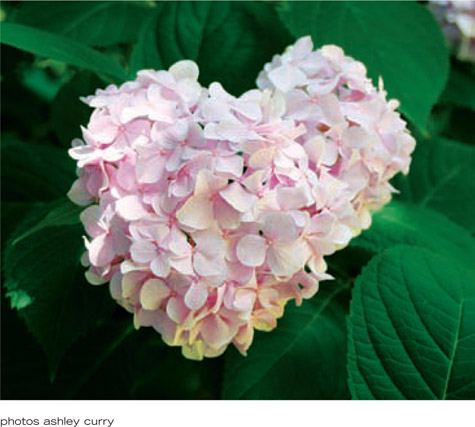
ABOVE: A pale pink hydrangea in bloom.

ABOVE: Over the years English ivy has nearly covered one of Leif’s buildings.
By midsummer the garden is in maintenance mode. Large bunches of broccoli and kale fill the front planter boxes, and morning glories climb the arched trellis over the gallery’s side door. Potted tomatoes are moved daily to catch the afternoon light, and Leif finds this year’s crop of burgundy sunflowers too perfect not to paint. Echinacea, rudbeckia, and phlox bloom brilliant purple, yellow, and pink in the back gardens, and a drift of white gooseneck loosestrife bends its collective heads toward the hillside. In the shade of a tall cedar tree, hummingbirds dance around the purple hosta flowers, while Stella de Oro daylilies offer their cadmium yellow blossoms to the sun. Amethyst globe thistle, pale pink mallow, and golden mustard bloom amid the euonymus atop the rock walls, and low-growing lady’s mantle spreads its ruffled leaves over the edges of pebbled paths.

The bright white of this ornate iron settee draws attention to the white balloon flowers blooming among golden yellow rudbeckia and the lavender spikes of hostas in the hillside above. ashley curry
Leif’s enthusiasm for his garden seems to be at least partially rooted in his ability to transform it almost at will.

ABOVE: Leif stands in front of a large canvas depicting downtown Chester, Connecticut.
For a moment in time, the gardens resemble Leif’s latest series of paintings. But from the top corner of the yard he surveys the layout and a new plan starts to take shape. He envisions a way to complete a circular path around the property, perhaps by building a bridge from the hillside to the studio or by constructing a staircase that completes the circle. Climbing hydrangeas might cover a tall privacy fence; native junipers, cedars, and laurels could flow down the hill. He may find the perfect spot for a magnolia if he cuts down one large spruce and donates it to the community for a Christmas tree; from a new sitting area at the very top of the property, he would be able to view that tree in the town square. And on a sunlit summer day he could set his easel in just the right spot in the garden and the cycle would begin again.
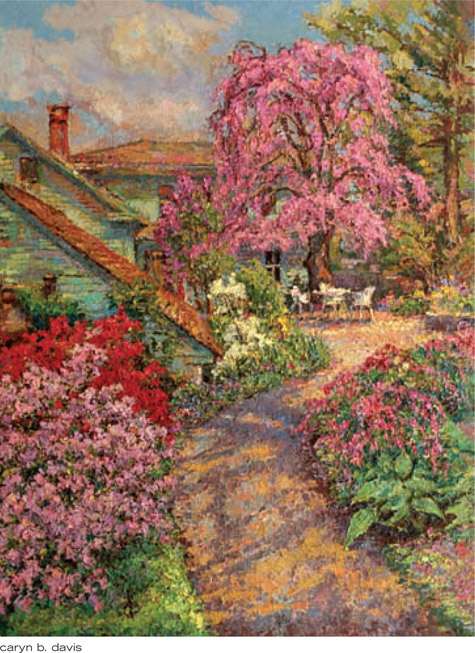
ABOVE: Backyard Garden is a spring view of the scene Leif has painted many times.
Caryn B. Davis
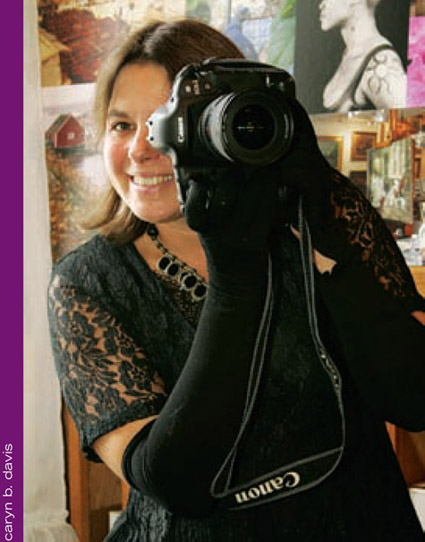
While Leif works on the layout of the landscape, his partner, Caryn B. Davis, concentrates on the details that create beautiful vignettes throughout the gardens. She walks the beaches in Connecticut and abroad in search of rocks and shells, and scours antiques shops for outdoor furniture and architectural remnants. A variety of pots and planters punctuate the patio with unexpected color, and wind chimes add their distinctive tone to the ambience. Often, when these elements come together in a particular way, Caryn is inspired to record them in photographs. She is attracted by contrast in the gardens, but also by color, an element that entered her visual vocabulary only in the last few years.
As a producer and director of documentary films in New York City, Caryn had an opportunity to travel the globe, which was the stimulus for her new career. Primarily self-taught, she was influenced by celebrated photographers Joyce Tenneson and Phil Borges, who encouraged her to choose a subject to record for a year in order to find her signature style. Today her extensive portfolio includes several series of in-depth studies on subjects ranging from Orbis International, a nonprofit organization fighting blindness in developing countries, to her recent Chester Stories, beautifully conceived and executed portraits of the residents of the town she calls home.
Until 2003 Caryn shot exclusively in black and white. On a trip to Nova Scotia with Leif, she found herself with a lot of time on her hands (his painting required that he stay in one location for an extended period). She began to experiment with color as abstraction and soon began to view the world in tones and hues, although she retained the strong graphic sense of her earlier work. Her photographs are sought by collectors and publications, in particular shelter magazines where her passion for interior and garden design is evidenced in her work. In the gardens, her creative touch is everywhere—in the brilliant red watering can against a gray stone step, the collection of beach stones on a rock wall, the vase of black-eyed Susans on a colorfully striped tablecloth, the placement of an antique bench. Although her career keeps her busy and mobile, she occasionally stops for a moment to capture a view of the fabulous gardens that she and Leif have built together.
